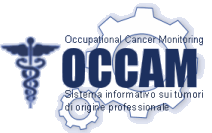- You are in: OCCAM / resources
resources
Il OCCAM (Occupational Cancer
Monitoring),
Its aim is to implement a system for occupational cancer risks with an archive of subjects
having cancer of likely occupational origin.
The OCCAM project estimates by economic activity of private sectors. These sectors are classified using the Italian Institute of Statistics (ISTAT) classification (ATECO 81). Codes are grouped in large economic sectors, e.g. Rubber, Leather, Transport etc. These groups have been determined by a panel of industrial hygenists, by grouping similar productions. This has been done as the number of subjects having the same statistical code was small.
Subjects have been classified as exposed in the case-control analyses, if they had worked at least for 12 months. In some analyses, only the longest economic activity has been considered. The reference group, i.e. the group of “non exposed” has been determined as formed by these subjects having an economic activity code pertaining to the sales and services sectors. For these activities non carcinogenic exposure in the work environment is likely. Subjects having worked both in “exposed” and “non exposed” categories have been considered as exposed.
A monitoring system based on passive notifications cannot work properly. Therefore a different system to catch risks and cases due to occupation based on information available, mainly in the data bases with pathological data and in data bases with occupational information has been established.
Data on the working history are available at the National Institute for Social Security (INPS) where for each individual, starting in 1974, all employment in firms of the private sector are stored with the coding of the economic activity of the firm. Codes relating to similar activities were grouped.
To estimate cancer risk by site and by economic activity, systems that record incident cases of residents in given areas were used: Cancer Registries, Hospital Discharge Records (SDO) and Mortality archives.
For a given area a case-control study has been implemented, comparing working histories of diseased people with working histories of healthy people.
